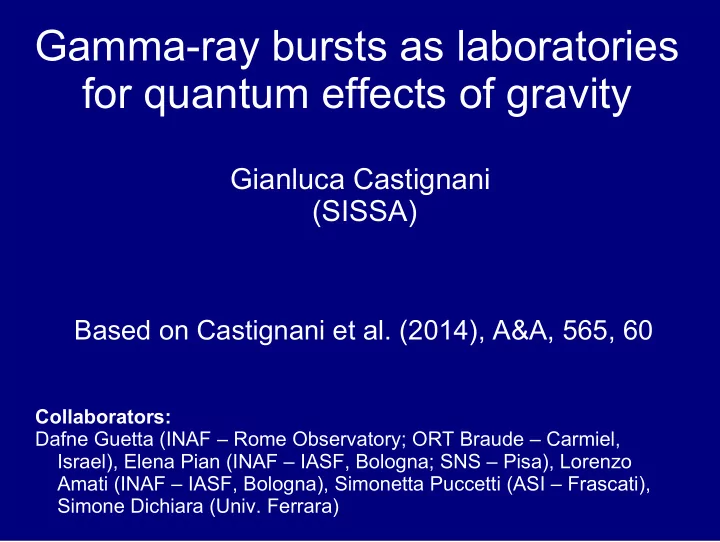

Gamma-ray bursts as laboratories for quantum effects of gravity Gianluca Castignani (SISSA) Based on Castignani et al. (2014), A&A, 565, 60 Collaborators: Dafne Guetta (INAF – Rome Observatory; ORT Braude – Carmiel, Israel), Elena Pian (INAF – IASF, Bologna; SNS – Pisa), Lorenzo Amati (INAF – IASF, Bologna), Simonetta Puccetti (ASI – Frascati), Simone Dichiara (Univ. Ferrara)
Gamma-ray bursts: general properties Current scenario: GRBs are powerful explosions, possibly asymmetric (jets), originated by stellar collapse or binary mergers Peak isotropic luminosities 10 50-53 erg s -1 at ~100 keV 10 – 1000 keV energy output 10 51-54 erg A few tens are detected at energies >~20 MeV (Fermi LAT, AGILE grid) [Marisaldi 2009, Ackermann et al. 2013] Cosmological distances (~10 at z>4, Coward et al. 2013 ) Short time-scale observed variability (δt>~1ms)
Short vs Long GRBs stellar collapse binary mergers(?) (broadly accepted scenario) Time distribution of GRBs detected by the BATSE instrument on the Compton Gamma-ray Observatory. [Credits: NASA Goddard Space Flight Center]
Fermi Gamma-ray space Telescope and GRBs Gamma-ray Burst Monitor ( GMB , Meegan et al. 2009 ); 8 keV – 40 MeV Large Area Telescope ( LAT , Atwood et al. 2009 ); 20 MeV–300 GeV The onset of the emission of the brightest GRBs at >100 MeV is systematically delayed with respect to the start of the GBM signal by <~a few sec (or a fraction of sec, for short GRBs) (Abdo et al. 2009a, b, c; Giuliani et al. 2010; Del Monte et al. 2011; Ackermann et al. 2011; Piron et al. 2012)
Two possible explanations for the delay Non classical Astrophysical relation dispersion processes occur E ≠ pc Different emitting regions associated with (Amelino-Camelia et al. 1998; GBM and LAT Nemiroff et al. 2011) emissions Δt ~= ΔE / (M QG c 2 )*(D/c) ΔE = E high - E low Time delays are used to set Prompt emission lower limits on M QG and test QG [Amelino-Camelia+13, Guetta+13, vs. afterglow Vasileiou+13; see also Stecker's and Granot's talks] (e.g. Ghirlanda et al. 2010)
Goals small LAT number count statistics + poor understanding of emission models (especially at LAT energies) Determine whether the time lags really exist and possibly quantify their uncertainties on the basis of the entire light curves
The Sample 1st Fermi LAT GRB catalog (35 GRBs up to 08/2011) 100MeV–10GeV fluence >0.6 10 -5 erg cm -2 Test Statistic TS >460 → GRB 080916C, 090510, 090902B, 090926A, and 110731A
The DCF (Edelson & Krolik 1988) Originally introduced to cross correlate (unevenly sampled) light curves of AGNs But also used for GRBs (Pian+2000, Ackermann+13) Adopted here to cross correlate discrete LCs with a possible different sampling The DCF binning partially overcomes the limitations deriving from small LAT number counts with respect to standard CCF
Simulations ...the DCF maxima/minima might still be spurious and due to statistical fluctuations + more robust and accurate estimates of the DCF peak locations N=10,000 GBM and LAT light curves randomly generated Poisson Statistics Simulated light curves pairwise compared by means of the DCF Peterson et al. (1998) approach
GRB 080916C 100 MeV – 300 GeV light curve 8-1000 KeV NaI light curve Castignani+14
GRB 080916C Castignani+14
GRB 080916C Castignani+14
GRB 090510 Castignani+14
GRB 090926A Castignani+14
GRB 090926A >=4σ significance Castignani+14
Results Single DCFs: time lags are formally consistent with zero (as e.g. Del Monte+2011) When simulations are considered time lags different from zero are always detected!! The presence of secondary maxima suggests the complexity of the LCs and the fact that the delays may be ascribed to intrinsic GRB physics
Summary and future work First estimates of the gamma- vs. hard- X-rays time lags in the five brighest LAT GRBs on the basis of the full Lcs Non-zero time lags are detected in all GRBs!!! Time lags may be due to intrinsic GRB physics Larger samples are nevertheless required to understand the origin of the time delays.
Recommend
More recommend